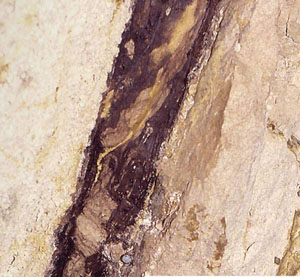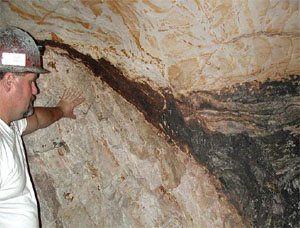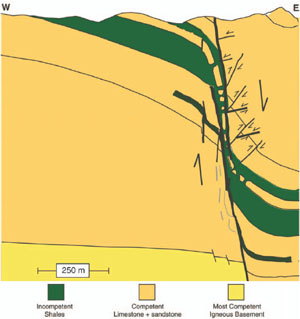| |||||||||
|
|
|||||||||
|
|
|||||||||
| Smeared Shale | |||||||||
|
Shale smear refers to the shale that is incorported into fault zones (Figure 1 and Figure 2) due to the vertical brittle and ductile anisotropy of rock layers in the faulted sequence. Shale smear occurs only in extentional relays made of interlayers of brittle and ductile rocks. For more discussion of the mechanism, please see the section Shale Smearing.
In the extensional stepover between echelon normal fault segments, shale gets stretched and thins as slip increases. The attenuation of shale continues in a manner that the shale is conformable with the fault segments on either side up to a certain point beyond which the smeared shale vanishes locally (Figure 3). The smale smear potential can be evaluated by identifing major fault segment on the seismic and mapping smeared shale on juxtaposition diagram (Koledoye et al, 2003). In the case of scarce data, rough estimation of shale smear potential can be made by the shale to gouge ratio or SGR. Please refer to the sections Shale Gouge Ratio and Geometry of Shale Smear for more discussion. Since shale has low permeability, if the shale smear is continuous along the fault, the fault will be a barrier to fluid flow in a more premeable layer. For more discussion, please refers to section Permeability Effected by Shale Smear. | |||||||||
| Reference: |
|||||||||
| Aydin, A., Eyal, Y., 1995 Aydin, A., Eyal, Y., 2002 Eichhubl, P., D'Onfro, P.S., Aydin, A., Waters, J., McCarty, D.K., 2004 Eichhubl, P., D'Onfro, P.S., Aydin, A., Waters, J., McCarty, D.K., 2005 Koledoye, B., Aydin, A., May, E., 2003 |
|||||||||
|
Readme | About Us | Acknowledgement | How to Cite | Terms of Use | Ⓒ Rock Fracture Knowledgebase |
|||||||||


